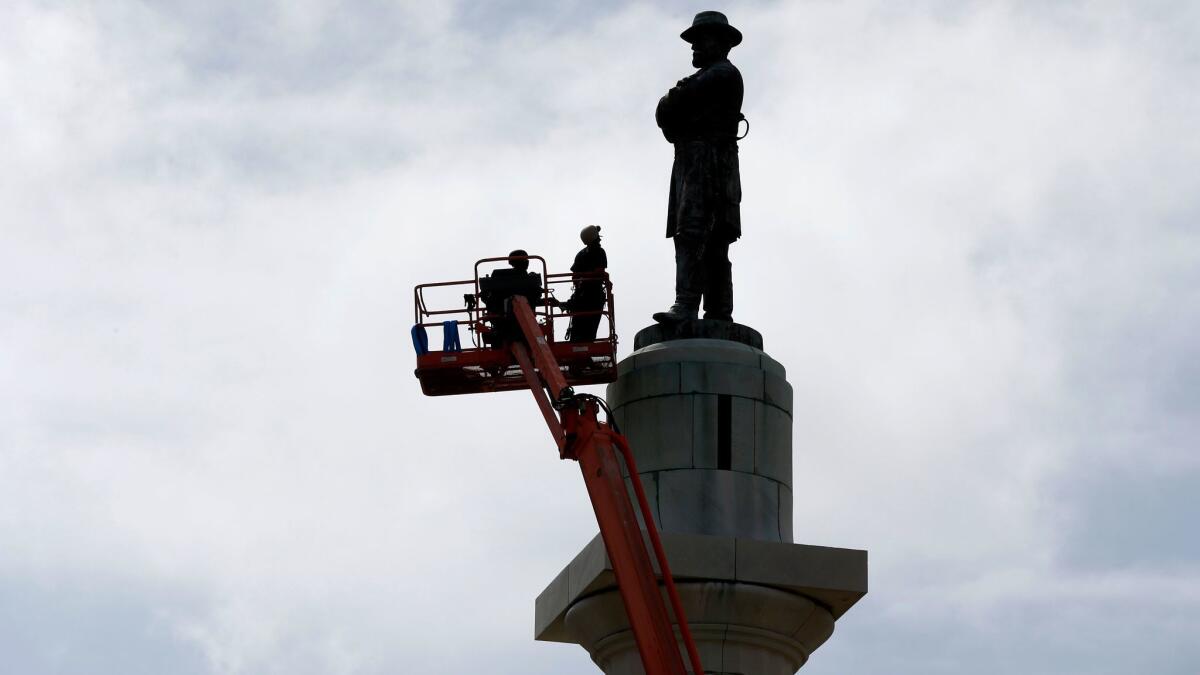Opinion: No, President Trump, Washington’s slaves and Lee’s treason are not the same things

- Share via
President Trump’s inability to discern the difference between neo-Nazis and those who oppose them was bad enough, but also mixed into that rambling train wreck of a news conference Tuesday was a layer of ignorance over the nature and symbolism of the Confederate statues the racists have been fighting to defend.
In addressing efforts to remove Confederate statues from public spaces, Trump parroted talking points that equate Robert E. Lee and others who tore the country apart 150 years ago with the slave-owning founders of the nation.
“George Washington was a slave owner,” Trump said. “Was George Washington a slave owner? So will George Washington now lose his status? Are we going to take down — excuse me — are we going to take down statues to George Washington? How about Thomas Jefferson? What do you think of Thomas Jefferson? You like him? Good. Are we going to take down the statue? ’Cause he was a major slave owner. Are we going to take down his statue? So you know what? It’s fine. You are changing history; you’re changing culture.”
But the issue isn’t whether Washington and Jefferson owned slaves. They did, and problematically so. But that’s not why the nation holds them in esteem. They are commemorated because of their role in founding the nation.
Compare that with Robert E. Lee, who quit the U.S. Army to join the Confederates. What is the term we’d use in the present for a military leader who quits and joins an army that is attacking the U.S.? Jefferson Davis was a feckless figure who served in the U.S. Senate with little impact before he became president of the Confederate States of America — a country that existed only in the minds of its creators (no other nation recognized its legitimacy). Nathan Bedford Forrest, who was a slave trader before the war, was a crucial figure to the rise of the Ku Klux Klan after the war ended.
These men, and others like them, sought to tear asunder the United States to preserve an economic and social system premised upon a belief in white supremacy and built on the enslavement of another race.
To venerate such men is to honor those responsible for the nation’s worst tragedy — the Civil War — and who were the violent defenders of our worst institution, slavery. Despite Trump’s parroting of the talking points, removing memorials to heroes of the Confederacy does not change history, it corrects testimonials to it.
They are monuments as much to the persistence of racism as they are to the men they depict.
Many of those statues were erected decades after the war ended and during the second rise of the Ku Klux Klan. They reflected efforts by Southern communities to rewrite the past, and in some cases, to intimidate African Americans already beaten down by Jim Crow laws and a caste system based on race. A statue of Lee in the town square sends the message, “The war might be over, but the South is still the South.”
As The Times editorial board noted in May as New Orleans removed some of its “false gods”:
“Despite the assertions of apologists, the war was not a fight to repel Northern aggression — the South fired first — nor to save a genteel agrarian culture. Those who continue to romanticize antebellum Dixie willingly embrace a world and economy that found its meaning and value in the violent subjugation of another race.”
There is no moral prism through which one can view with pride the generals and soldiers who went to war to keep others in chains. That the president of the United States doesn’t understand that might not be surprising, but it is still contemptible. And the monuments should continue to be moved to where they belong — museums, in displays framed with the proper context. Because in the end, they are monuments as much to the persistence of racism as they are to the men they depict.
Follow my posts and re-tweets at @smartelle on Twitter
More to Read
A cure for the common opinion
Get thought-provoking perspectives with our weekly newsletter.
You may occasionally receive promotional content from the Los Angeles Times.











